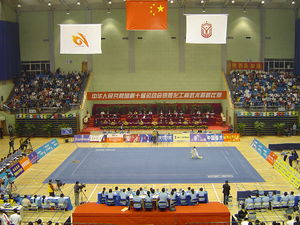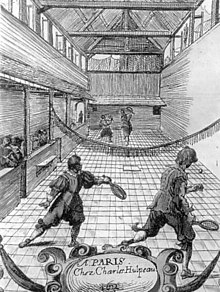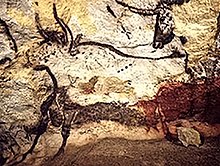The sport of wushu is both an exhibition and a full-contact sport derived from traditional Chinese martial arts. It was developed in China after 1949, in an effort to standardize the practice of traditional Chinese martial arts, although attempts to structure the various decentralized martial arts traditions date back earlier, when the Central Guoshu Institute was established at Nanking in 1928. The term wushu is Chinese for "martial arts" (武 "Wu" = military or martial, 术 "Shu" = art). In contemporary times, wushu has become an international sport through the International Wushu Federation (IWUF), which holds the World Wushu Championships every two years; the first World Championships were held in 1991 in Beijing and won by Yuan Wen Qing.
Tampilkan postingan dengan label Normatif. Tampilkan semua postingan
Tampilkan postingan dengan label Normatif. Tampilkan semua postingan
Selasa, 04 Desember 2012
Wushu (Sport)
Diposting oleh
Unknown
di
04.15
0
komentar
Kirimkan Ini lewat Email
BlogThis!
Bagikan ke X
Berbagi ke Facebook

Label:
Normatif
Chinese martial arts training (Sport)
Chinese martial arts training consists of the following components:
basics, forms, applications and weapons; different styles place varying
emphasis on each component. In addition, philosophy, ethics and even medical practice
are highly regarded by most Chinese martial arts. A complete training
system should also provide insight into Chinese attitudes and culture.
Diposting oleh
Unknown
di
04.09
0
komentar
Kirimkan Ini lewat Email
BlogThis!
Bagikan ke X
Berbagi ke Facebook

Label:
Normatif
Jumat, 30 November 2012
History of tennis (Sport)
Most historians believe that tennis
originated in France in the 12th century, but the ball was then struck
with the palm of the hand. It was not until the 16th century that rackets
came into use, and the game began to be called "tennis." It was popular
in England and France, although the game was only played indoors where
the ball could be hit off the wall. This later created much controversy
between many people who thought that it was unfair for the opposing
team. They claimed that the other team was able to hit the ball in a
certain way for it to hit the wall and come back to them. Henry VIII of England was a big fan of this game, which historians now refer to as real tennis.
Diposting oleh
Unknown
di
16.46
0
komentar
Kirimkan Ini lewat Email
BlogThis!
Bagikan ke X
Berbagi ke Facebook

Label:
Normatif
American football rules (Sport)
Game play in American football consists of a series of downs, individual plays of short duration, outside of which the ball is dead or not in play. These can be plays from scrimmage—passes, runs, punts, or field goal attempts—or free kicks such as kickoffs. Substitutions can be made between downs, which allows for a great deal of specialization as coaches
choose the players best suited for each particular situation. During a
play, each team should have no more than 11 players on the field, and
each of them has specific tasks assigned for that specific play.
Diposting oleh
Unknown
di
05.23
0
komentar
Kirimkan Ini lewat Email
BlogThis!
Bagikan ke X
Berbagi ke Facebook

Label:
Normatif
Sepak takraw (Sport)
Sepak takraw , or kick volleyball, is a sport native to the Malay-Thai Peninsula. Sepak takraw differs from the similar sport of volleyball in its use of a rattan ball and only allowing players to use their feet, knee, chest and head to touch the ball. It is a popular sport in Southeast Asia.
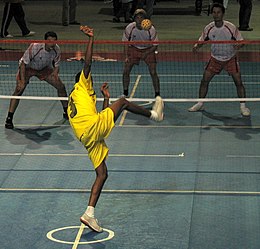 |
| Sepak takraw |
Diposting oleh
Unknown
di
04.32
0
komentar
Kirimkan Ini lewat Email
BlogThis!
Bagikan ke X
Berbagi ke Facebook

Label:
Normatif
Kamis, 29 November 2012
Quran (Islamic)
The Quran, also transliterated Qur'an, Koran, Al-Coran, Coran, Kuran, and Al-Qur'an, is the central religious text of Islam, which Muslims believe to be the verbatim word of God (Arabic: الله, Allah). It is regarded widely as the finest piece of literature in the Arabic language.
 |
| Al-Qurʾān - (القرآن) |
Diposting oleh
Unknown
di
02.43
0
komentar
Kirimkan Ini lewat Email
BlogThis!
Bagikan ke X
Berbagi ke Facebook

Label:
Normatif
Five Pillars of Islam (Islamic)
The Five Pillars of Islam (arkān-al-Islām أركان الإسلام; also arkān ad-dīn أركان الدين "pillars of the religion") are five basic acts in Islam, considered obligatory by believers and are the foundation of Muslim life. These are summarized in the famous hadith of Gabriel.
 |
| Islam |
Diposting oleh
Unknown
di
02.40
0
komentar
Kirimkan Ini lewat Email
BlogThis!
Bagikan ke X
Berbagi ke Facebook

Label:
Normatif
Islam (Islamic)
Islam (English  /ˈɪzlɑːm/; Arabic: الإسلام al-ʾislām IPA: [ʔɪsˈlæːm] is a monotheistic and Abrahamic religion articulated by the Qur'an, a text considered by its adherents to be the verbatim word of God (Arabic: الله Allāh) and by the teachings and normative example (called the Sunnah and composed of Hadith) of Muhammad, considered by them to be the last prophet of God. An adherent of Islam is called a Muslim.
/ˈɪzlɑːm/; Arabic: الإسلام al-ʾislām IPA: [ʔɪsˈlæːm] is a monotheistic and Abrahamic religion articulated by the Qur'an, a text considered by its adherents to be the verbatim word of God (Arabic: الله Allāh) and by the teachings and normative example (called the Sunnah and composed of Hadith) of Muhammad, considered by them to be the last prophet of God. An adherent of Islam is called a Muslim.
Diposting oleh
Unknown
di
02.33
0
komentar
Kirimkan Ini lewat Email
BlogThis!
Bagikan ke X
Berbagi ke Facebook

Label:
Normatif
Kung fu/Kungfu (Sport)
Kung fu/Kungfu or Gung fu/Gongfu (功夫, Pinyin: gōngfu) is a Chinese
term referring to any study, learning, or practice that requires
patience, energy, and time to complete, often used in the West to refer
to Chinese martial arts, also known as Wushu. It is only in the late twentieth century, that this term was used in relation to Chinese Martial Arts by the Chinese community. The Oxford English Dictionary defines the term "Kung-fu" as "a primarily unarmed Chinese martial art resembling karate."
This illustrates how this term has been misused in English. The origin
of this misuse can be attributed to the misunderstanding or
mistranslation of the term through movie subtitles or dubbing.
 |
| Chinese martial arts |
Diposting oleh
Unknown
di
02.20
0
komentar
Kirimkan Ini lewat Email
BlogThis!
Bagikan ke X
Berbagi ke Facebook

Label:
Normatif
Senin, 26 November 2012
Pencak Silat (Sport)
 |
| Pencak silat demonstration in Jakarta. |
Diposting oleh
Unknown
di
02.47
0
komentar
Kirimkan Ini lewat Email
BlogThis!
Bagikan ke X
Berbagi ke Facebook

Label:
Normatif
Portrait painting (Art)
 |
| The official Chinese court portrait painting of Empress Cao (wife of Emperor Renzong) of Song Dynasty |
Diposting oleh
Unknown
di
02.27
0
komentar
Kirimkan Ini lewat Email
BlogThis!
Bagikan ke X
Berbagi ke Facebook

Label:
Normatif
Landscape painting (Art)
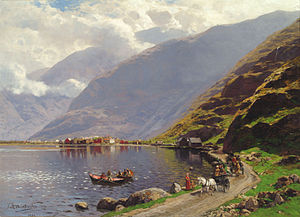 |
| Themistokles von Eckenbrecher (German, 1842–1921), View of Laerdalsoren, on the Sognefjord, 1901 |
 |
| Hasegawa Tōhaku, Pine Trees, one of a pair of folding screens, Japan, 1593. 156.8 × 356 cm (61.73 × 140.16 in) |
Diposting oleh
Unknown
di
02.16
0
komentar
Kirimkan Ini lewat Email
BlogThis!
Bagikan ke X
Berbagi ke Facebook

Label:
Normatif
Persian miniature (Art)
 |
| Advice of the Ascetic (c. 1500-1550). As in Western illuminated manuscripts, exquisitely decorated borders were an integral part of the work of art. |
Diposting oleh
Unknown
di
02.03
0
komentar
Kirimkan Ini lewat Email
BlogThis!
Bagikan ke X
Berbagi ke Facebook

Label:
Normatif
History of art (Art)
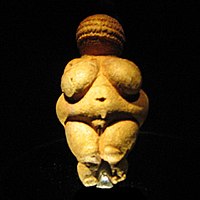 |
Venus of Willendorf, circa 24,000–22,000 BP
|
Diposting oleh
Unknown
di
01.42
0
komentar
Kirimkan Ini lewat Email
BlogThis!
Bagikan ke X
Berbagi ke Facebook

Label:
Normatif
Jumat, 23 November 2012
Sketch - drawing (Art)
A sketch (ultimately from Greek σχέδιος – schedios, "done extempore") is a rapidly executed freehand drawing that is not usually intended as a finished work.
A sketch may serve a number of purposes: it might record something that
the artist sees, it might record or develop an idea for later use or it
might be used as a quick way of graphically demonstrating an image,
idea or principle. Sketching is generally a prescribed part of the
studies of art students.
The term "sketch" has most often been applied to graphic work executed in a dry media such as graphite pencil, charcoal or pastel. It may also apply to drawings executed in pen and ink, ballpoint pen, water colour and oil paint. The latter two are generally referred to as "water colour sketches" and "oil sketches". A sculptor might model three-dimensional sketches in clay or plasticine.
The term "sketchbook" refers to a book of blank paper on which an artist can, (or has already) drawn sketches. The book might be purchased bound or might comprise loose leaves of sketches assembled or bound together.
Most visual artists use, to a greater or lesser degree, the sketch as a method of recording or working out ideas. The sketchbooks of some individual artists have become very well known, including those of Leonardo da Vinci and Edgar Degas which have become art objects in their own right, with many pages showing finished studies as well as sketches.
The ability to quickly record impressions through sketching has found varied purposes in today's culture. Courtroom artists are usually sketchers. Sketches drawn to help authorities find or identify wanted people are called composite sketches. Street performers in popular tourist areas often include artists who sketch portraits within minutes.
The term "sketch" has most often been applied to graphic work executed in a dry media such as graphite pencil, charcoal or pastel. It may also apply to drawings executed in pen and ink, ballpoint pen, water colour and oil paint. The latter two are generally referred to as "water colour sketches" and "oil sketches". A sculptor might model three-dimensional sketches in clay or plasticine.
The term "sketchbook" refers to a book of blank paper on which an artist can, (or has already) drawn sketches. The book might be purchased bound or might comprise loose leaves of sketches assembled or bound together.
Most visual artists use, to a greater or lesser degree, the sketch as a method of recording or working out ideas. The sketchbooks of some individual artists have become very well known, including those of Leonardo da Vinci and Edgar Degas which have become art objects in their own right, with many pages showing finished studies as well as sketches.
The ability to quickly record impressions through sketching has found varied purposes in today's culture. Courtroom artists are usually sketchers. Sketches drawn to help authorities find or identify wanted people are called composite sketches. Street performers in popular tourist areas often include artists who sketch portraits within minutes.
Diposting oleh
Unknown
di
04.57
0
komentar
Kirimkan Ini lewat Email
BlogThis!
Bagikan ke X
Berbagi ke Facebook

Label:
Normatif
Idioms of painting (Art)
Allegory
Allegory is a figurative mode of representation conveying meaning other than the literal. Allegory communicates its message by means of symbolic figures, actions or symbolic representation. Allegory is generally treated as a figure of rhetoric, but an allegory does not have to be expressed in language: it may be addressed to the eye, and is often found in realistic painting. An example of a simple visual allegory is the image of the grim reaper. Viewers understand that the image of the grim reaper is a symbolic representation of death.
Diposting oleh
Unknown
di
04.49
0
komentar
Kirimkan Ini lewat Email
BlogThis!
Bagikan ke X
Berbagi ke Facebook

Label:
Normatif
Painting media (Art)
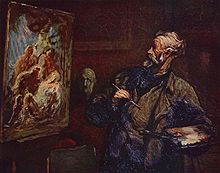 |
| Honoré Daumier (1808–79), The Painter |
Diposting oleh
Unknown
di
04.45
0
komentar
Kirimkan Ini lewat Email
BlogThis!
Bagikan ke X
Berbagi ke Facebook

Label:
Normatif
Elements of painting (Art)
Intensity
What enables painting is the perception and representation of intensity. Every point in space has different intensity, which can be represented in painting by black and white and all the gray shades between. In practice, painters can articulate shapes by juxtaposing surfaces of different intensity; by using just color (of the same intensity) one can only represent symbolic shapes. Thus, the basic means of painting are distinct from ideological means, such as geometrical figures, various points of view and organization (perspective), and symbols. For example, a painter perceives that a particular white wall has different intensity at each point, due to shades and reflections from nearby objects, but ideally, a white wall is still a white wall in pitch darkness. In technical drawing, thickness of line is also ideal, demarcating ideal outlines of an object within a perceptual frame different from the one used by painters.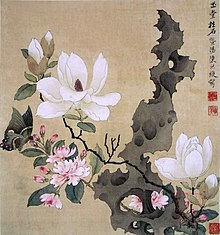 |
| Chen Hongshou (1598–1652), Leaf album painting (Ming Dynasty) |
Diposting oleh
Unknown
di
04.38
0
komentar
Kirimkan Ini lewat Email
BlogThis!
Bagikan ke X
Berbagi ke Facebook

Label:
Normatif
History of painting (Art)
The oldest known paintings are at the Grotte Chauvet in France, claimed by some historians to be about 32,000 years old. They are engraved and painted using red ochre
and black pigment and show horses, rhinoceros, lions, buffalo, mammoth,
abstract designs and what are possibly partial human figures. However
the earliest evidence of the act of painting has been discovered in two
rock-shelters in Arnhem Land,
in northern Australia. In the lowest layer of material at these sites
there are used pieces of ochre estimated to be 60,000 years old.
Archaeologists have also found a fragment of rock painting preserved in a
limestone rock-shelter in the Kimberley region of North-Western Australia, that is dated 40 000 years old. There are examples of cave paintings all over the world—in India, France, Spain, Portugal, China, Australia, etc.
In Western cultures oil painting and watercolor painting have rich and complex traditions in style and subject matter. In the East, ink and color ink historically predominated the choice of media with equally rich and complex traditions.
In Western cultures oil painting and watercolor painting have rich and complex traditions in style and subject matter. In the East, ink and color ink historically predominated the choice of media with equally rich and complex traditions.
Diposting oleh
Unknown
di
04.34
0
komentar
Kirimkan Ini lewat Email
BlogThis!
Bagikan ke X
Berbagi ke Facebook

Label:
Normatif
Music (Art)
Music is an art form whose medium is sound and silence. Its common elements are pitch (which governs melody and harmony), rhythm (and its associated concepts tempo, meter, and articulation), dynamics, and the sonic qualities of timbre and texture. The word derives from Greek μουσική (mousike; "art of the Muses").
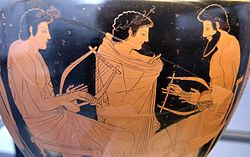 |
| A painting on an Ancient Greek vase depicts a music lesson (c. 510 BC). |
Diposting oleh
Unknown
di
04.25
0
komentar
Kirimkan Ini lewat Email
BlogThis!
Bagikan ke X
Berbagi ke Facebook

Label:
Normatif
